PRECEDE-PROCEED Model: Improving Maternal Health During Pregnancy
VerifiedAdded on 2023/04/22
|9
|2826
|57
Report
AI Summary
This report details the application of the PRECEDE-PROCEED model to enhance pregnancy outcomes and reduce maternal and infant mortality. It explains the eight phases of the precede part, including social assessment, epidemiological and behavioral assessment, educational and ecological assessment, administrative and policy diagnosis, and program implementation. The report emphasizes the importance of process evaluation, impact evaluation, and outcome evaluation to measure the effectiveness of the interventions. It also highlights the need for behavioral change, lifestyle adjustments, and comprehensive healthcare during pregnancy to ensure the well-being of both the mother and child. The report concludes that the Precede-Proceed Model is a valuable tool for community-based health initiatives and public health services, promoting voluntary behavioral change and active participation from both implementers and beneficiaries.

THE APPLICATION OF “PRECEDE-PROCEED” MODEL TO PREGNANCY OF WOMAN
Precede Proceed Model
STUDENT NAME
UNIVERSITY
Precede Proceed Model
STUDENT NAME
UNIVERSITY
Paraphrase This Document
Need a fresh take? Get an instant paraphrase of this document with our AI Paraphraser
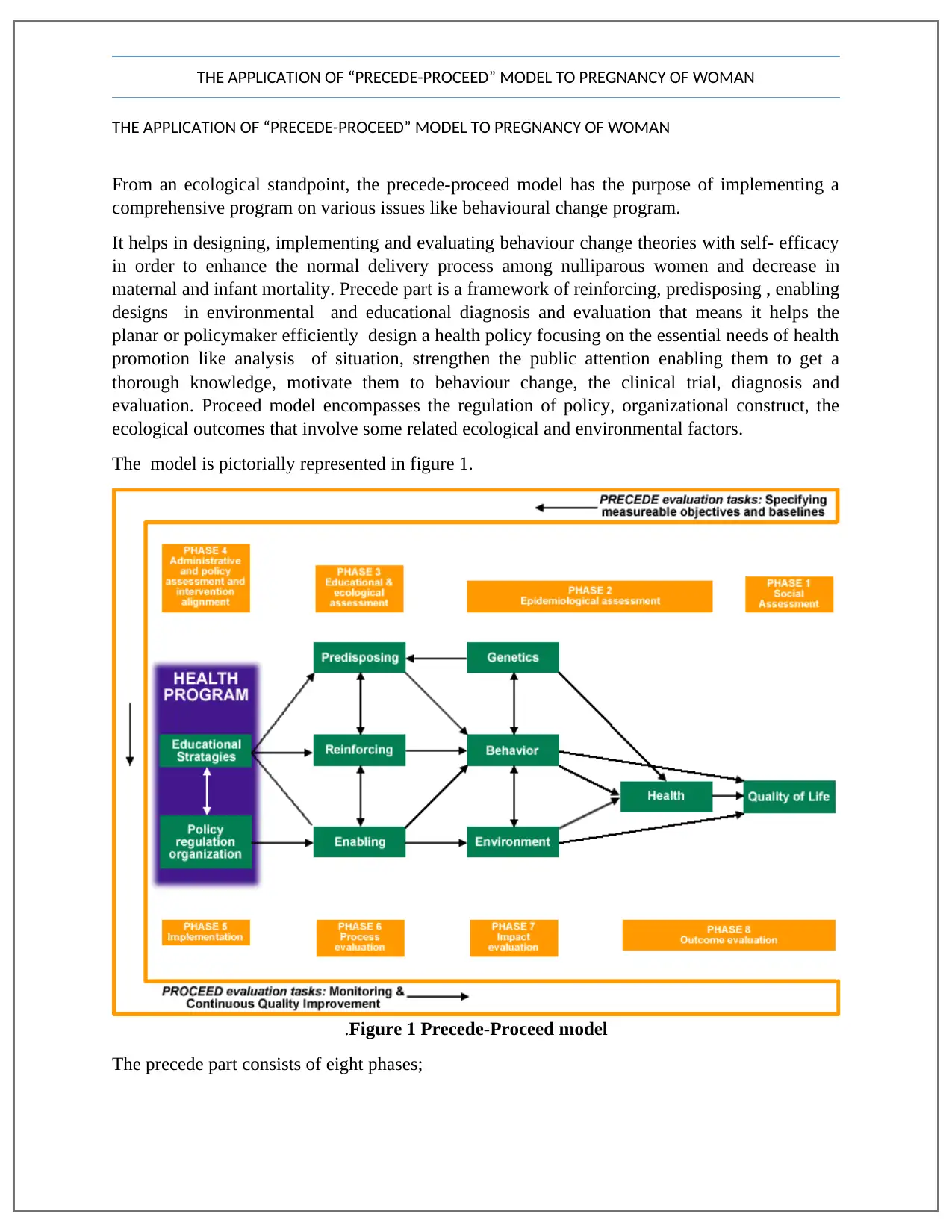
THE APPLICATION OF “PRECEDE-PROCEED” MODEL TO PREGNANCY OF WOMAN
THE APPLICATION OF “PRECEDE-PROCEED” MODEL TO PREGNANCY OF WOMAN
From an ecological standpoint, the precede-proceed model has the purpose of implementing a
comprehensive program on various issues like behavioural change program.
It helps in designing, implementing and evaluating behaviour change theories with self- efficacy
in order to enhance the normal delivery process among nulliparous women and decrease in
maternal and infant mortality. Precede part is a framework of reinforcing, predisposing , enabling
designs in environmental and educational diagnosis and evaluation that means it helps the
planar or policymaker efficiently design a health policy focusing on the essential needs of health
promotion like analysis of situation, strengthen the public attention enabling them to get a
thorough knowledge, motivate them to behaviour change, the clinical trial, diagnosis and
evaluation. Proceed model encompasses the regulation of policy, organizational construct, the
ecological outcomes that involve some related ecological and environmental factors.
The model is pictorially represented in figure 1.
.Figure 1 Precede-Proceed model
The precede part consists of eight phases;
THE APPLICATION OF “PRECEDE-PROCEED” MODEL TO PREGNANCY OF WOMAN
From an ecological standpoint, the precede-proceed model has the purpose of implementing a
comprehensive program on various issues like behavioural change program.
It helps in designing, implementing and evaluating behaviour change theories with self- efficacy
in order to enhance the normal delivery process among nulliparous women and decrease in
maternal and infant mortality. Precede part is a framework of reinforcing, predisposing , enabling
designs in environmental and educational diagnosis and evaluation that means it helps the
planar or policymaker efficiently design a health policy focusing on the essential needs of health
promotion like analysis of situation, strengthen the public attention enabling them to get a
thorough knowledge, motivate them to behaviour change, the clinical trial, diagnosis and
evaluation. Proceed model encompasses the regulation of policy, organizational construct, the
ecological outcomes that involve some related ecological and environmental factors.
The model is pictorially represented in figure 1.
.Figure 1 Precede-Proceed model
The precede part consists of eight phases;

THE APPLICATION OF “PRECEDE-PROCEED” MODEL TO PREGNANCY OF WOMAN
THE APPLICATION OF “PRECEDE-PROCEED” MODEL TO PREGNANCY OF WOMAN
Phase 1: social assessment- This is the beginning stage in planning process which includes the
identification and proper assessment (Crosby & Noar, 2011, p S7-S15) of social problems like
maternal and infant mortality. The purpose of this program is the behavior change like reducing
the fear of the pregnant woman during the time of childbirth and also focusses on the morbidity
and mortality of both mother and the child a legal approach is taken for this reason by
conducting various activities like holding a planning committee and several community forum in
different areas. The policy-maker would skillfully assess the situation by conducting various
activities to develop the mutual understanding between the pregnant women along with their
families and the policymaker by a detailed discussion about pregnant mother’s health, fitness,
environmental and psychological condition etc., survey and clinical trial. The discussion would
be all about child and mother’s safety, precautionary steps that should be taken for the common
good.
The policy maker should skillfully design the program to interact with the pregnant woman along
with their family to join in activities and inspire them through the process of campaigning, media
or printed material. So the organizational network can expand broadly from the grass root level
to every social arena. The organizer should take the survey with a watchful mind by comparing
the behaviour/lifestyle and environmental factors and follow the written document.
Intervention mapping is an essential tool that allows the planar to assess the actual strength and
requirements of the target group. As for example; Sahara Africa is a disease prone area where
pregnant women are at high risk of suffering from communicable diseases as well as disease due
to malnutrition. It is reported that intervention mapping helps us solving these serious problems
through the consistent and formative work for the health and well-being of women and their
offspring. The concept focusses on the target group having complication and health service is
provided with the support from global trajectories to reduce the maternal and child mortality.
Phase 2: Epidemiological and behavioural assessment
Epidemiological diagnosis is the data collection regarding the behaviour and lifestyle, specific
disease prone area and environment. As the lifestyle is different in rural to urban area, their
custom behavioural aspects would be different, safety measures should be taken in a specific
disease prone area which is another environmental factor.
A thorough counselling is needed for the pregnant woman coming from different types of society
and having different health problems like obesity and genetic risk, so that the planar would
acknowledge the physical and mental condition, specifically of diseases of the pregnant woman.
(Aviram, Hod, & Yogev, 2011, p S6-S10)
Phase 3: Educational and Ecological Assessment and selection of interventions.
As and when the previous factors i.e. behavioural and environmental factors are ascertained, then
the planar can plan how to proceed by selecting the predisposing factors to motivate the
behavioural change with the help of educational knowledge and wisdom in a more convincing
THE APPLICATION OF “PRECEDE-PROCEED” MODEL TO PREGNANCY OF WOMAN
Phase 1: social assessment- This is the beginning stage in planning process which includes the
identification and proper assessment (Crosby & Noar, 2011, p S7-S15) of social problems like
maternal and infant mortality. The purpose of this program is the behavior change like reducing
the fear of the pregnant woman during the time of childbirth and also focusses on the morbidity
and mortality of both mother and the child a legal approach is taken for this reason by
conducting various activities like holding a planning committee and several community forum in
different areas. The policy-maker would skillfully assess the situation by conducting various
activities to develop the mutual understanding between the pregnant women along with their
families and the policymaker by a detailed discussion about pregnant mother’s health, fitness,
environmental and psychological condition etc., survey and clinical trial. The discussion would
be all about child and mother’s safety, precautionary steps that should be taken for the common
good.
The policy maker should skillfully design the program to interact with the pregnant woman along
with their family to join in activities and inspire them through the process of campaigning, media
or printed material. So the organizational network can expand broadly from the grass root level
to every social arena. The organizer should take the survey with a watchful mind by comparing
the behaviour/lifestyle and environmental factors and follow the written document.
Intervention mapping is an essential tool that allows the planar to assess the actual strength and
requirements of the target group. As for example; Sahara Africa is a disease prone area where
pregnant women are at high risk of suffering from communicable diseases as well as disease due
to malnutrition. It is reported that intervention mapping helps us solving these serious problems
through the consistent and formative work for the health and well-being of women and their
offspring. The concept focusses on the target group having complication and health service is
provided with the support from global trajectories to reduce the maternal and child mortality.
Phase 2: Epidemiological and behavioural assessment
Epidemiological diagnosis is the data collection regarding the behaviour and lifestyle, specific
disease prone area and environment. As the lifestyle is different in rural to urban area, their
custom behavioural aspects would be different, safety measures should be taken in a specific
disease prone area which is another environmental factor.
A thorough counselling is needed for the pregnant woman coming from different types of society
and having different health problems like obesity and genetic risk, so that the planar would
acknowledge the physical and mental condition, specifically of diseases of the pregnant woman.
(Aviram, Hod, & Yogev, 2011, p S6-S10)
Phase 3: Educational and Ecological Assessment and selection of interventions.
As and when the previous factors i.e. behavioural and environmental factors are ascertained, then
the planar can plan how to proceed by selecting the predisposing factors to motivate the
behavioural change with the help of educational knowledge and wisdom in a more convincing
⊘ This is a preview!⊘
Do you want full access?
Subscribe today to unlock all pages.

Trusted by 1+ million students worldwide
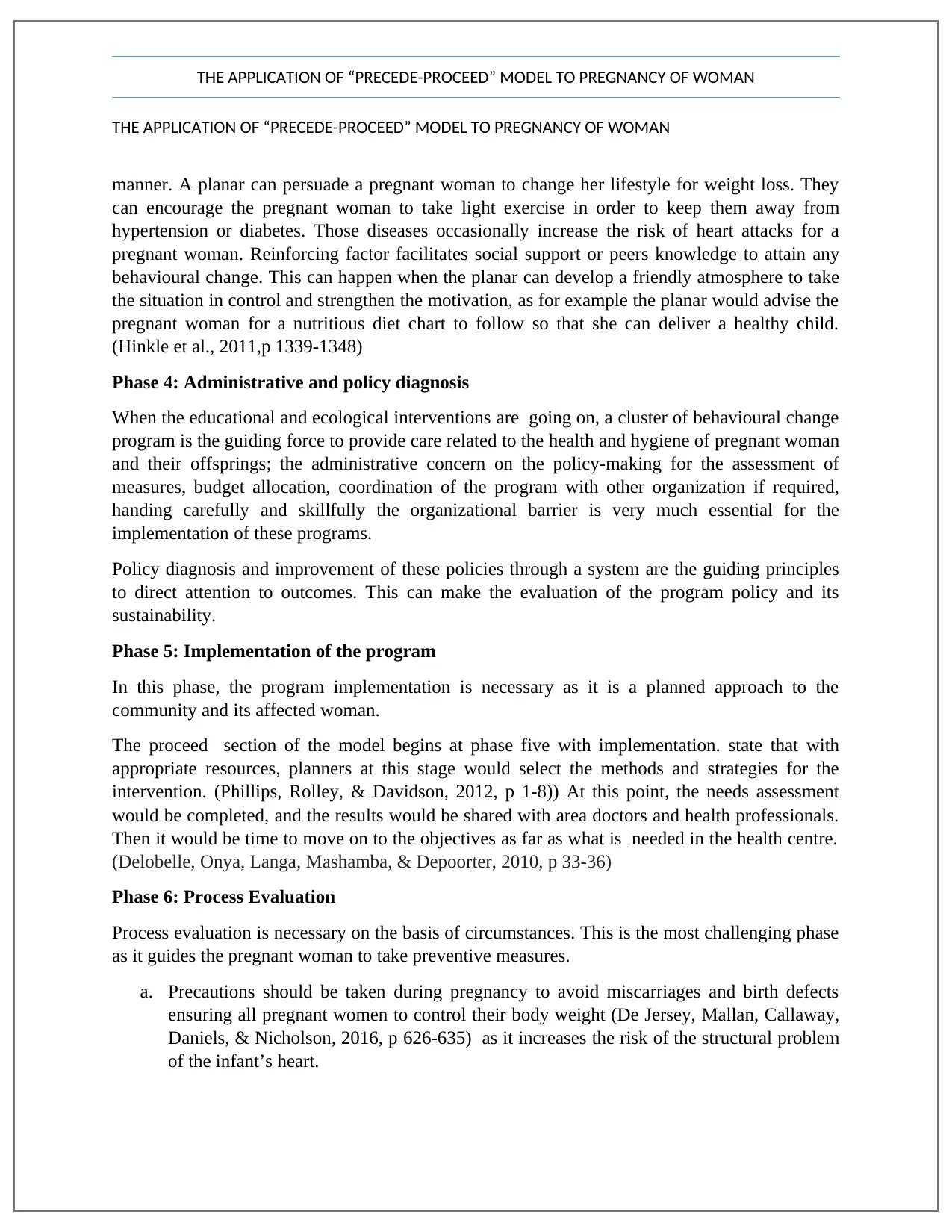
THE APPLICATION OF “PRECEDE-PROCEED” MODEL TO PREGNANCY OF WOMAN
THE APPLICATION OF “PRECEDE-PROCEED” MODEL TO PREGNANCY OF WOMAN
manner. A planar can persuade a pregnant woman to change her lifestyle for weight loss. They
can encourage the pregnant woman to take light exercise in order to keep them away from
hypertension or diabetes. Those diseases occasionally increase the risk of heart attacks for a
pregnant woman. Reinforcing factor facilitates social support or peers knowledge to attain any
behavioural change. This can happen when the planar can develop a friendly atmosphere to take
the situation in control and strengthen the motivation, as for example the planar would advise the
pregnant woman for a nutritious diet chart to follow so that she can deliver a healthy child.
(Hinkle et al., 2011,p 1339-1348)
Phase 4: Administrative and policy diagnosis
When the educational and ecological interventions are going on, a cluster of behavioural change
program is the guiding force to provide care related to the health and hygiene of pregnant woman
and their offsprings; the administrative concern on the policy-making for the assessment of
measures, budget allocation, coordination of the program with other organization if required,
handing carefully and skillfully the organizational barrier is very much essential for the
implementation of these programs.
Policy diagnosis and improvement of these policies through a system are the guiding principles
to direct attention to outcomes. This can make the evaluation of the program policy and its
sustainability.
Phase 5: Implementation of the program
In this phase, the program implementation is necessary as it is a planned approach to the
community and its affected woman.
The proceed section of the model begins at phase five with implementation. state that with
appropriate resources, planners at this stage would select the methods and strategies for the
intervention. (Phillips, Rolley, & Davidson, 2012, p 1-8)) At this point, the needs assessment
would be completed, and the results would be shared with area doctors and health professionals.
Then it would be time to move on to the objectives as far as what is needed in the health centre.
(Delobelle, Onya, Langa, Mashamba, & Depoorter, 2010, p 33-36)
Phase 6: Process Evaluation
Process evaluation is necessary on the basis of circumstances. This is the most challenging phase
as it guides the pregnant woman to take preventive measures.
a. Precautions should be taken during pregnancy to avoid miscarriages and birth defects
ensuring all pregnant women to control their body weight (De Jersey, Mallan, Callaway,
Daniels, & Nicholson, 2016, p 626-635) as it increases the risk of the structural problem
of the infant’s heart.
THE APPLICATION OF “PRECEDE-PROCEED” MODEL TO PREGNANCY OF WOMAN
manner. A planar can persuade a pregnant woman to change her lifestyle for weight loss. They
can encourage the pregnant woman to take light exercise in order to keep them away from
hypertension or diabetes. Those diseases occasionally increase the risk of heart attacks for a
pregnant woman. Reinforcing factor facilitates social support or peers knowledge to attain any
behavioural change. This can happen when the planar can develop a friendly atmosphere to take
the situation in control and strengthen the motivation, as for example the planar would advise the
pregnant woman for a nutritious diet chart to follow so that she can deliver a healthy child.
(Hinkle et al., 2011,p 1339-1348)
Phase 4: Administrative and policy diagnosis
When the educational and ecological interventions are going on, a cluster of behavioural change
program is the guiding force to provide care related to the health and hygiene of pregnant woman
and their offsprings; the administrative concern on the policy-making for the assessment of
measures, budget allocation, coordination of the program with other organization if required,
handing carefully and skillfully the organizational barrier is very much essential for the
implementation of these programs.
Policy diagnosis and improvement of these policies through a system are the guiding principles
to direct attention to outcomes. This can make the evaluation of the program policy and its
sustainability.
Phase 5: Implementation of the program
In this phase, the program implementation is necessary as it is a planned approach to the
community and its affected woman.
The proceed section of the model begins at phase five with implementation. state that with
appropriate resources, planners at this stage would select the methods and strategies for the
intervention. (Phillips, Rolley, & Davidson, 2012, p 1-8)) At this point, the needs assessment
would be completed, and the results would be shared with area doctors and health professionals.
Then it would be time to move on to the objectives as far as what is needed in the health centre.
(Delobelle, Onya, Langa, Mashamba, & Depoorter, 2010, p 33-36)
Phase 6: Process Evaluation
Process evaluation is necessary on the basis of circumstances. This is the most challenging phase
as it guides the pregnant woman to take preventive measures.
a. Precautions should be taken during pregnancy to avoid miscarriages and birth defects
ensuring all pregnant women to control their body weight (De Jersey, Mallan, Callaway,
Daniels, & Nicholson, 2016, p 626-635) as it increases the risk of the structural problem
of the infant’s heart.
Paraphrase This Document
Need a fresh take? Get an instant paraphrase of this document with our AI Paraphraser

THE APPLICATION OF “PRECEDE-PROCEED” MODEL TO PREGNANCY OF WOMAN
THE APPLICATION OF “PRECEDE-PROCEED” MODEL TO PREGNANCY OF WOMAN
b. For the healthy development of the baby, the pregnant woman should take a healthy diet
and lifestyle (Koju, 2015,p 189-190) and join the clinical trial to avoid prenatal and post-
natal complications.(Buta et al., 2011,p 867-875)
c. If the conceivable woman is a habitual smoker then it increases the chances of sudden
infant death syndrome. Therefore the planar would ensure the pregnant woman to abstain
from tobacco and avoid passive smoking. (GILLIGAN et al., 2009, p 35-40)
d. Ensuring them not to use alcohol or processed food and make a healthy food choice, take
supplements for folic acid to avoid birth defects and to take hydrated food to support
oxygen and nutrition requirements of the offspring. (Loureiro et al., 2009, p 29-38)
e. Maintaining a light exercise like breathing exercise at the time of pregnancy as it is good
for pregnant mother as well as the growing infant. (Norris, 2011,p s37-s40)
f. Ensure for a trained and experienced attendant other than a regular untrained attendant.
Good pre-natal and post-natal care would reduce the risk of mortality. (Payne, Lister,
West, & Bernhardt, 2015,p e20)
g. Several risk factors are associated with the obese, young age or aged woman which can
cause difficulties during childbirth. (Stockwell et al., 2010,p 925-931)
h. Suffering from high blood pressure can lead to premature delivery and need specialized
care for survival.
Phase 7: Impact Evaluation
This phase is very much important in measuring the effectiveness of the program and
performance of the planar or policymaker. One of the impacts of the model is the
knowledge imparted regarding the behavioural pattern and lifestyle maintenance during
pregnancy. If all the precautions as envisaged in the model is followed, the delivery of
the infant will be a smooth affair.
Phase 8: Outcome evaluation
. This phase is totally result oriented regarding the health-related issues and the
motivation and behavioural changes. Whether the intervention which was supposed to
bring about the outcome identified in phase 1 is working or not, is analyzed in this phase.
If the outcome is not as per desired level then we have to start the process again to see
what went wrong and identify others that may work. There may be some outcomes that
may not be felt for years or decades. Young people who have chosen a particular lifestyle
may not accept any suggestion until they are in their middle ages and start developing
heart diseases. In some cases outcome may expose immediately, it takes prolonged time
to reveal resulting in the continuous monitoring and feedback. (Walsh, White, &
Kattelmann, 2014,p s1-s9))
In the case of a pregnant woman, the majority of the cases are successful if all the steps
of the precede-proceed model are followed.
THE APPLICATION OF “PRECEDE-PROCEED” MODEL TO PREGNANCY OF WOMAN
b. For the healthy development of the baby, the pregnant woman should take a healthy diet
and lifestyle (Koju, 2015,p 189-190) and join the clinical trial to avoid prenatal and post-
natal complications.(Buta et al., 2011,p 867-875)
c. If the conceivable woman is a habitual smoker then it increases the chances of sudden
infant death syndrome. Therefore the planar would ensure the pregnant woman to abstain
from tobacco and avoid passive smoking. (GILLIGAN et al., 2009, p 35-40)
d. Ensuring them not to use alcohol or processed food and make a healthy food choice, take
supplements for folic acid to avoid birth defects and to take hydrated food to support
oxygen and nutrition requirements of the offspring. (Loureiro et al., 2009, p 29-38)
e. Maintaining a light exercise like breathing exercise at the time of pregnancy as it is good
for pregnant mother as well as the growing infant. (Norris, 2011,p s37-s40)
f. Ensure for a trained and experienced attendant other than a regular untrained attendant.
Good pre-natal and post-natal care would reduce the risk of mortality. (Payne, Lister,
West, & Bernhardt, 2015,p e20)
g. Several risk factors are associated with the obese, young age or aged woman which can
cause difficulties during childbirth. (Stockwell et al., 2010,p 925-931)
h. Suffering from high blood pressure can lead to premature delivery and need specialized
care for survival.
Phase 7: Impact Evaluation
This phase is very much important in measuring the effectiveness of the program and
performance of the planar or policymaker. One of the impacts of the model is the
knowledge imparted regarding the behavioural pattern and lifestyle maintenance during
pregnancy. If all the precautions as envisaged in the model is followed, the delivery of
the infant will be a smooth affair.
Phase 8: Outcome evaluation
. This phase is totally result oriented regarding the health-related issues and the
motivation and behavioural changes. Whether the intervention which was supposed to
bring about the outcome identified in phase 1 is working or not, is analyzed in this phase.
If the outcome is not as per desired level then we have to start the process again to see
what went wrong and identify others that may work. There may be some outcomes that
may not be felt for years or decades. Young people who have chosen a particular lifestyle
may not accept any suggestion until they are in their middle ages and start developing
heart diseases. In some cases outcome may expose immediately, it takes prolonged time
to reveal resulting in the continuous monitoring and feedback. (Walsh, White, &
Kattelmann, 2014,p s1-s9))
In the case of a pregnant woman, the majority of the cases are successful if all the steps
of the precede-proceed model are followed.
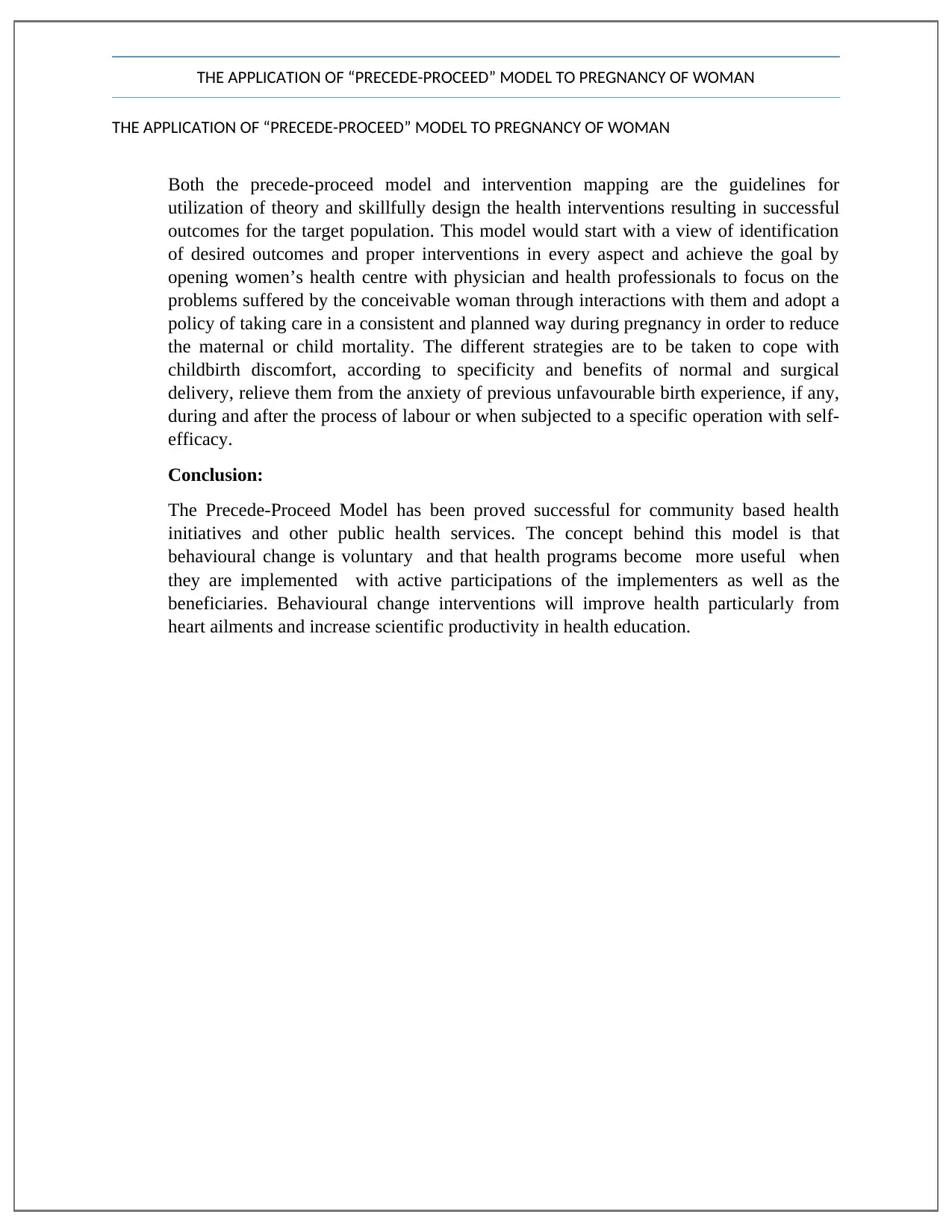
THE APPLICATION OF “PRECEDE-PROCEED” MODEL TO PREGNANCY OF WOMAN
THE APPLICATION OF “PRECEDE-PROCEED” MODEL TO PREGNANCY OF WOMAN
Both the precede-proceed model and intervention mapping are the guidelines for
utilization of theory and skillfully design the health interventions resulting in successful
outcomes for the target population. This model would start with a view of identification
of desired outcomes and proper interventions in every aspect and achieve the goal by
opening women’s health centre with physician and health professionals to focus on the
problems suffered by the conceivable woman through interactions with them and adopt a
policy of taking care in a consistent and planned way during pregnancy in order to reduce
the maternal or child mortality. The different strategies are to be taken to cope with
childbirth discomfort, according to specificity and benefits of normal and surgical
delivery, relieve them from the anxiety of previous unfavourable birth experience, if any,
during and after the process of labour or when subjected to a specific operation with self-
efficacy.
Conclusion:
The Precede-Proceed Model has been proved successful for community based health
initiatives and other public health services. The concept behind this model is that
behavioural change is voluntary and that health programs become more useful when
they are implemented with active participations of the implementers as well as the
beneficiaries. Behavioural change interventions will improve health particularly from
heart ailments and increase scientific productivity in health education.
THE APPLICATION OF “PRECEDE-PROCEED” MODEL TO PREGNANCY OF WOMAN
Both the precede-proceed model and intervention mapping are the guidelines for
utilization of theory and skillfully design the health interventions resulting in successful
outcomes for the target population. This model would start with a view of identification
of desired outcomes and proper interventions in every aspect and achieve the goal by
opening women’s health centre with physician and health professionals to focus on the
problems suffered by the conceivable woman through interactions with them and adopt a
policy of taking care in a consistent and planned way during pregnancy in order to reduce
the maternal or child mortality. The different strategies are to be taken to cope with
childbirth discomfort, according to specificity and benefits of normal and surgical
delivery, relieve them from the anxiety of previous unfavourable birth experience, if any,
during and after the process of labour or when subjected to a specific operation with self-
efficacy.
Conclusion:
The Precede-Proceed Model has been proved successful for community based health
initiatives and other public health services. The concept behind this model is that
behavioural change is voluntary and that health programs become more useful when
they are implemented with active participations of the implementers as well as the
beneficiaries. Behavioural change interventions will improve health particularly from
heart ailments and increase scientific productivity in health education.
⊘ This is a preview!⊘
Do you want full access?
Subscribe today to unlock all pages.

Trusted by 1+ million students worldwide
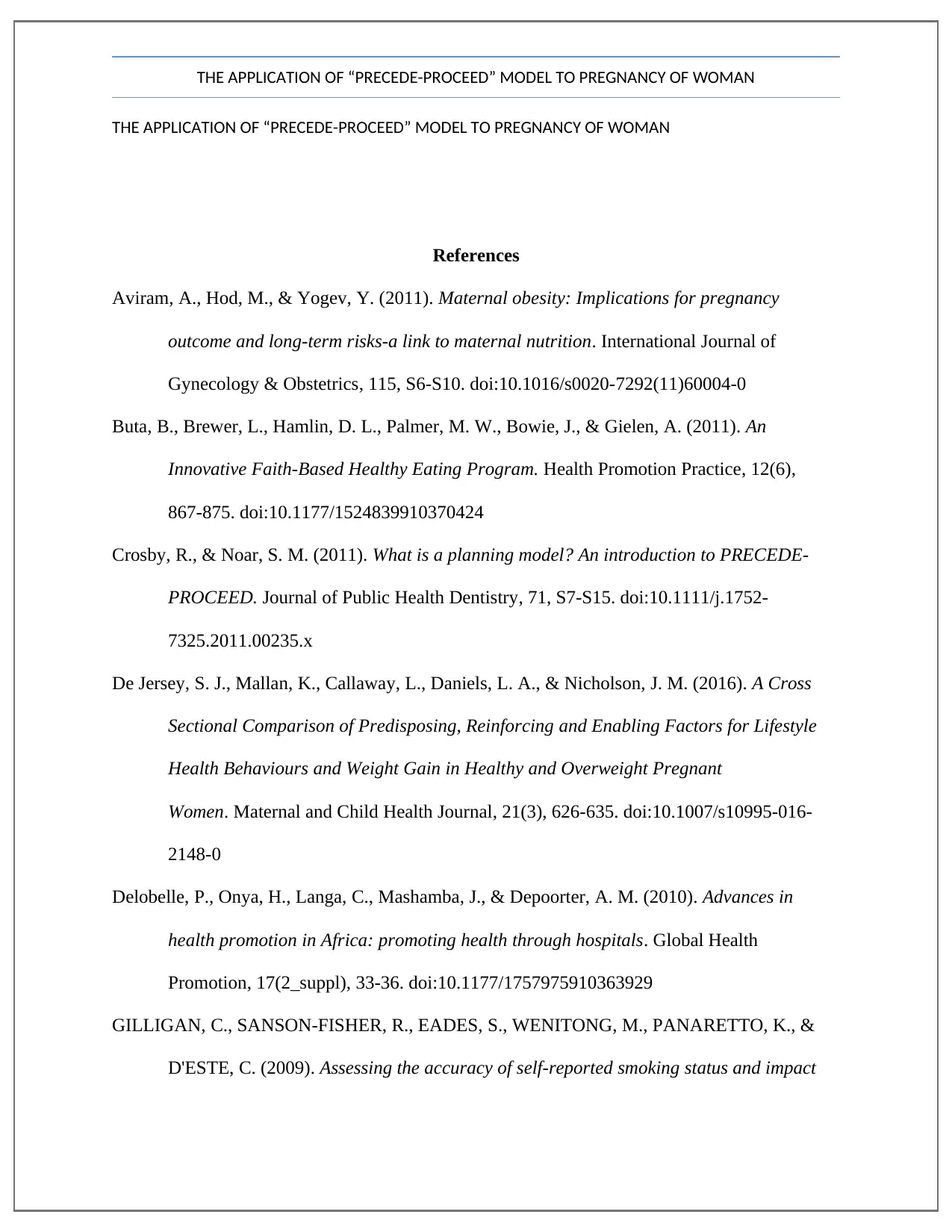
THE APPLICATION OF “PRECEDE-PROCEED” MODEL TO PREGNANCY OF WOMAN
THE APPLICATION OF “PRECEDE-PROCEED” MODEL TO PREGNANCY OF WOMAN
References
Aviram, A., Hod, M., & Yogev, Y. (2011). Maternal obesity: Implications for pregnancy
outcome and long-term risks-a link to maternal nutrition. International Journal of
Gynecology & Obstetrics, 115, S6-S10. doi:10.1016/s0020-7292(11)60004-0
Buta, B., Brewer, L., Hamlin, D. L., Palmer, M. W., Bowie, J., & Gielen, A. (2011). An
Innovative Faith-Based Healthy Eating Program. Health Promotion Practice, 12(6),
867-875. doi:10.1177/1524839910370424
Crosby, R., & Noar, S. M. (2011). What is a planning model? An introduction to PRECEDE-
PROCEED. Journal of Public Health Dentistry, 71, S7-S15. doi:10.1111/j.1752-
7325.2011.00235.x
De Jersey, S. J., Mallan, K., Callaway, L., Daniels, L. A., & Nicholson, J. M. (2016). A Cross
Sectional Comparison of Predisposing, Reinforcing and Enabling Factors for Lifestyle
Health Behaviours and Weight Gain in Healthy and Overweight Pregnant
Women. Maternal and Child Health Journal, 21(3), 626-635. doi:10.1007/s10995-016-
2148-0
Delobelle, P., Onya, H., Langa, C., Mashamba, J., & Depoorter, A. M. (2010). Advances in
health promotion in Africa: promoting health through hospitals. Global Health
Promotion, 17(2_suppl), 33-36. doi:10.1177/1757975910363929
GILLIGAN, C., SANSON-FISHER, R., EADES, S., WENITONG, M., PANARETTO, K., &
D'ESTE, C. (2009). Assessing the accuracy of self-reported smoking status and impact
THE APPLICATION OF “PRECEDE-PROCEED” MODEL TO PREGNANCY OF WOMAN
References
Aviram, A., Hod, M., & Yogev, Y. (2011). Maternal obesity: Implications for pregnancy
outcome and long-term risks-a link to maternal nutrition. International Journal of
Gynecology & Obstetrics, 115, S6-S10. doi:10.1016/s0020-7292(11)60004-0
Buta, B., Brewer, L., Hamlin, D. L., Palmer, M. W., Bowie, J., & Gielen, A. (2011). An
Innovative Faith-Based Healthy Eating Program. Health Promotion Practice, 12(6),
867-875. doi:10.1177/1524839910370424
Crosby, R., & Noar, S. M. (2011). What is a planning model? An introduction to PRECEDE-
PROCEED. Journal of Public Health Dentistry, 71, S7-S15. doi:10.1111/j.1752-
7325.2011.00235.x
De Jersey, S. J., Mallan, K., Callaway, L., Daniels, L. A., & Nicholson, J. M. (2016). A Cross
Sectional Comparison of Predisposing, Reinforcing and Enabling Factors for Lifestyle
Health Behaviours and Weight Gain in Healthy and Overweight Pregnant
Women. Maternal and Child Health Journal, 21(3), 626-635. doi:10.1007/s10995-016-
2148-0
Delobelle, P., Onya, H., Langa, C., Mashamba, J., & Depoorter, A. M. (2010). Advances in
health promotion in Africa: promoting health through hospitals. Global Health
Promotion, 17(2_suppl), 33-36. doi:10.1177/1757975910363929
GILLIGAN, C., SANSON-FISHER, R., EADES, S., WENITONG, M., PANARETTO, K., &
D'ESTE, C. (2009). Assessing the accuracy of self-reported smoking status and impact
Paraphrase This Document
Need a fresh take? Get an instant paraphrase of this document with our AI Paraphraser
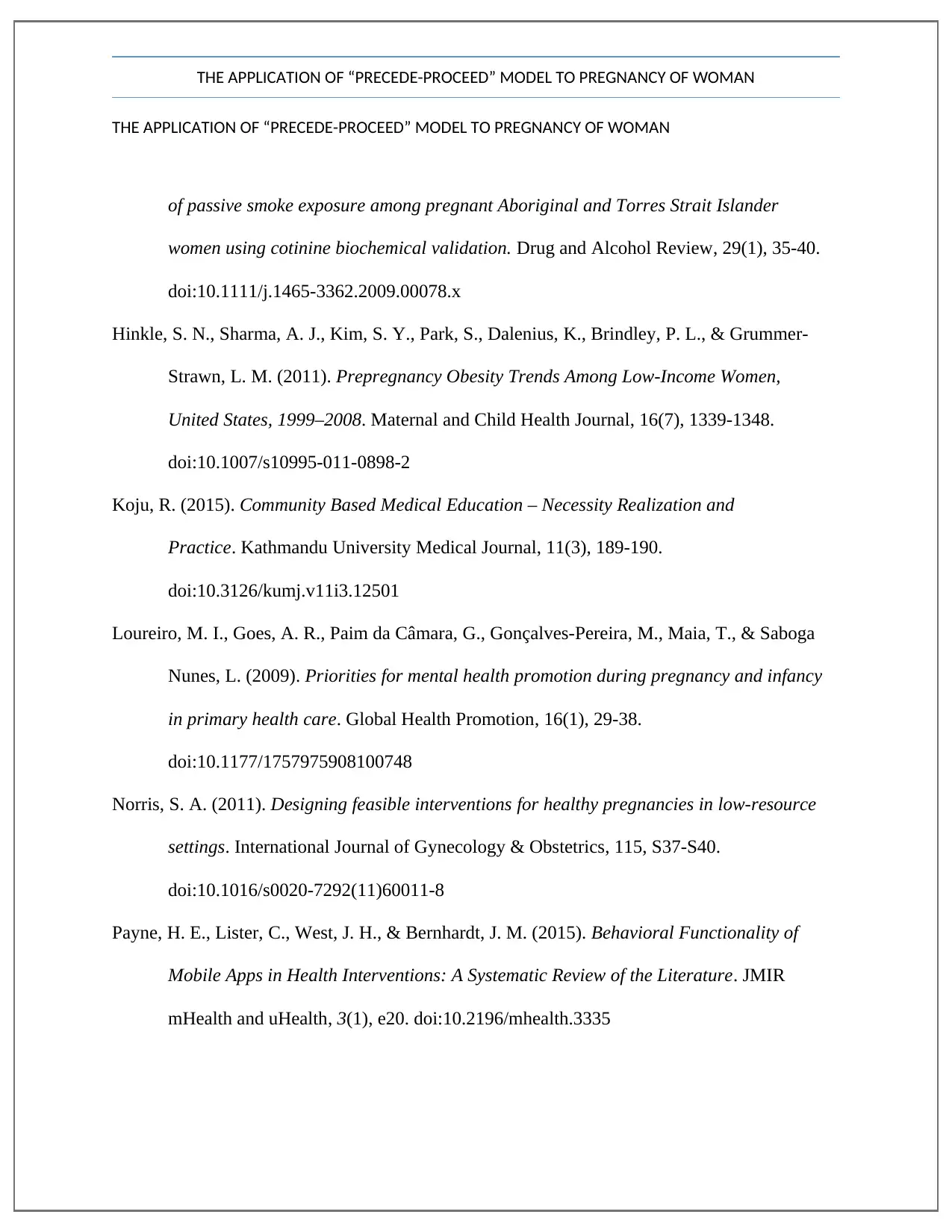
THE APPLICATION OF “PRECEDE-PROCEED” MODEL TO PREGNANCY OF WOMAN
THE APPLICATION OF “PRECEDE-PROCEED” MODEL TO PREGNANCY OF WOMAN
of passive smoke exposure among pregnant Aboriginal and Torres Strait Islander
women using cotinine biochemical validation. Drug and Alcohol Review, 29(1), 35-40.
doi:10.1111/j.1465-3362.2009.00078.x
Hinkle, S. N., Sharma, A. J., Kim, S. Y., Park, S., Dalenius, K., Brindley, P. L., & Grummer-
Strawn, L. M. (2011). Prepregnancy Obesity Trends Among Low-Income Women,
United States, 1999–2008. Maternal and Child Health Journal, 16(7), 1339-1348.
doi:10.1007/s10995-011-0898-2
Koju, R. (2015). Community Based Medical Education – Necessity Realization and
Practice. Kathmandu University Medical Journal, 11(3), 189-190.
doi:10.3126/kumj.v11i3.12501
Loureiro, M. I., Goes, A. R., Paim da Câmara, G., Gonçalves-Pereira, M., Maia, T., & Saboga
Nunes, L. (2009). Priorities for mental health promotion during pregnancy and infancy
in primary health care. Global Health Promotion, 16(1), 29-38.
doi:10.1177/1757975908100748
Norris, S. A. (2011). Designing feasible interventions for healthy pregnancies in low-resource
settings. International Journal of Gynecology & Obstetrics, 115, S37-S40.
doi:10.1016/s0020-7292(11)60011-8
Payne, H. E., Lister, C., West, J. H., & Bernhardt, J. M. (2015). Behavioral Functionality of
Mobile Apps in Health Interventions: A Systematic Review of the Literature. JMIR
mHealth and uHealth, 3(1), e20. doi:10.2196/mhealth.3335
THE APPLICATION OF “PRECEDE-PROCEED” MODEL TO PREGNANCY OF WOMAN
of passive smoke exposure among pregnant Aboriginal and Torres Strait Islander
women using cotinine biochemical validation. Drug and Alcohol Review, 29(1), 35-40.
doi:10.1111/j.1465-3362.2009.00078.x
Hinkle, S. N., Sharma, A. J., Kim, S. Y., Park, S., Dalenius, K., Brindley, P. L., & Grummer-
Strawn, L. M. (2011). Prepregnancy Obesity Trends Among Low-Income Women,
United States, 1999–2008. Maternal and Child Health Journal, 16(7), 1339-1348.
doi:10.1007/s10995-011-0898-2
Koju, R. (2015). Community Based Medical Education – Necessity Realization and
Practice. Kathmandu University Medical Journal, 11(3), 189-190.
doi:10.3126/kumj.v11i3.12501
Loureiro, M. I., Goes, A. R., Paim da Câmara, G., Gonçalves-Pereira, M., Maia, T., & Saboga
Nunes, L. (2009). Priorities for mental health promotion during pregnancy and infancy
in primary health care. Global Health Promotion, 16(1), 29-38.
doi:10.1177/1757975908100748
Norris, S. A. (2011). Designing feasible interventions for healthy pregnancies in low-resource
settings. International Journal of Gynecology & Obstetrics, 115, S37-S40.
doi:10.1016/s0020-7292(11)60011-8
Payne, H. E., Lister, C., West, J. H., & Bernhardt, J. M. (2015). Behavioral Functionality of
Mobile Apps in Health Interventions: A Systematic Review of the Literature. JMIR
mHealth and uHealth, 3(1), e20. doi:10.2196/mhealth.3335
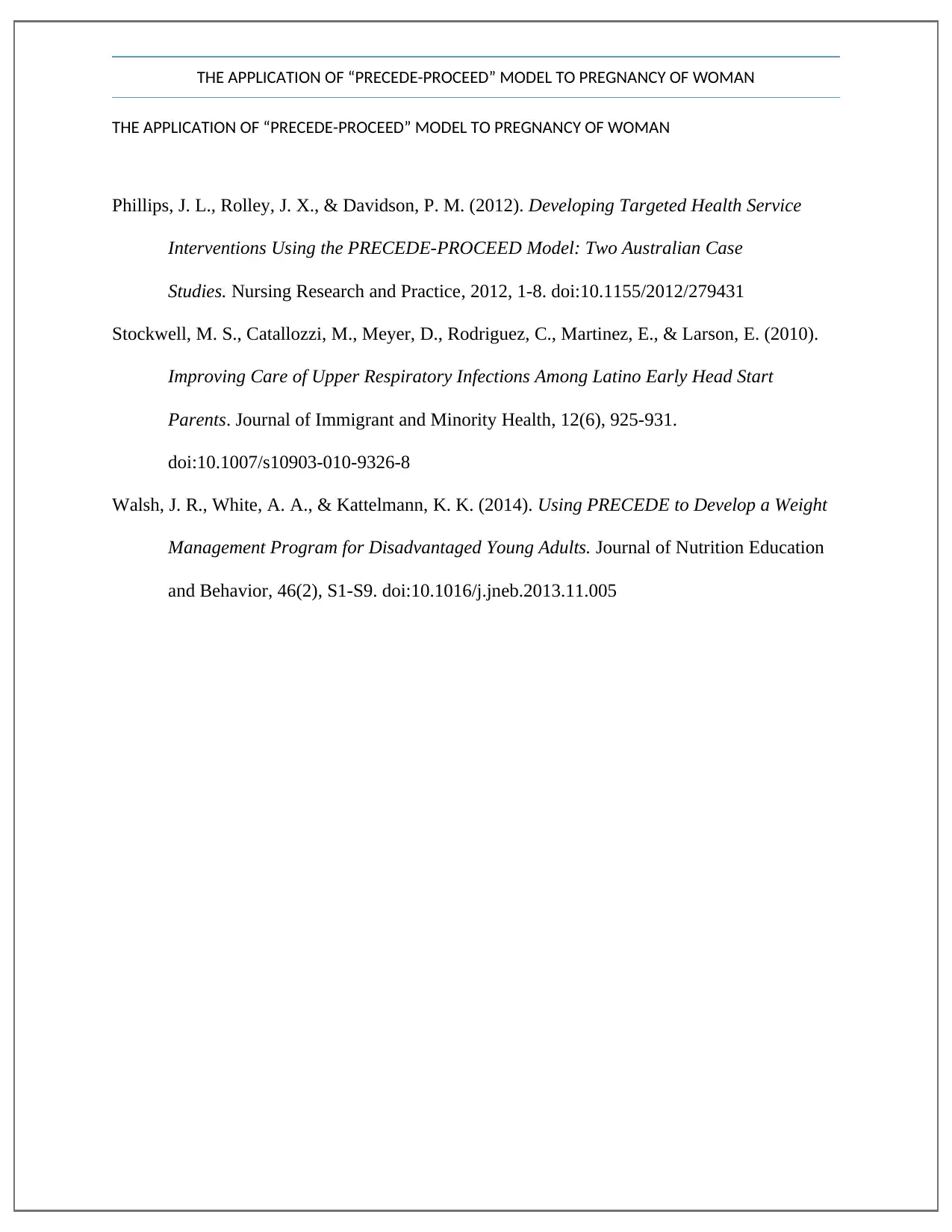
THE APPLICATION OF “PRECEDE-PROCEED” MODEL TO PREGNANCY OF WOMAN
THE APPLICATION OF “PRECEDE-PROCEED” MODEL TO PREGNANCY OF WOMAN
Phillips, J. L., Rolley, J. X., & Davidson, P. M. (2012). Developing Targeted Health Service
Interventions Using the PRECEDE-PROCEED Model: Two Australian Case
Studies. Nursing Research and Practice, 2012, 1-8. doi:10.1155/2012/279431
Stockwell, M. S., Catallozzi, M., Meyer, D., Rodriguez, C., Martinez, E., & Larson, E. (2010).
Improving Care of Upper Respiratory Infections Among Latino Early Head Start
Parents. Journal of Immigrant and Minority Health, 12(6), 925-931.
doi:10.1007/s10903-010-9326-8
Walsh, J. R., White, A. A., & Kattelmann, K. K. (2014). Using PRECEDE to Develop a Weight
Management Program for Disadvantaged Young Adults. Journal of Nutrition Education
and Behavior, 46(2), S1-S9. doi:10.1016/j.jneb.2013.11.005
THE APPLICATION OF “PRECEDE-PROCEED” MODEL TO PREGNANCY OF WOMAN
Phillips, J. L., Rolley, J. X., & Davidson, P. M. (2012). Developing Targeted Health Service
Interventions Using the PRECEDE-PROCEED Model: Two Australian Case
Studies. Nursing Research and Practice, 2012, 1-8. doi:10.1155/2012/279431
Stockwell, M. S., Catallozzi, M., Meyer, D., Rodriguez, C., Martinez, E., & Larson, E. (2010).
Improving Care of Upper Respiratory Infections Among Latino Early Head Start
Parents. Journal of Immigrant and Minority Health, 12(6), 925-931.
doi:10.1007/s10903-010-9326-8
Walsh, J. R., White, A. A., & Kattelmann, K. K. (2014). Using PRECEDE to Develop a Weight
Management Program for Disadvantaged Young Adults. Journal of Nutrition Education
and Behavior, 46(2), S1-S9. doi:10.1016/j.jneb.2013.11.005
⊘ This is a preview!⊘
Do you want full access?
Subscribe today to unlock all pages.

Trusted by 1+ million students worldwide
1 out of 9
Your All-in-One AI-Powered Toolkit for Academic Success.
+13062052269
info@desklib.com
Available 24*7 on WhatsApp / Email
![[object Object]](/_next/static/media/star-bottom.7253800d.svg)
Unlock your academic potential
Copyright © 2020–2025 A2Z Services. All Rights Reserved. Developed and managed by ZUCOL.

